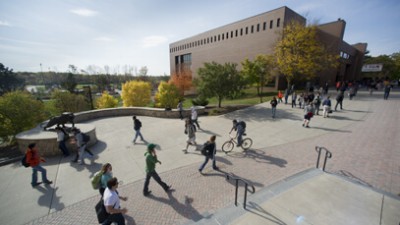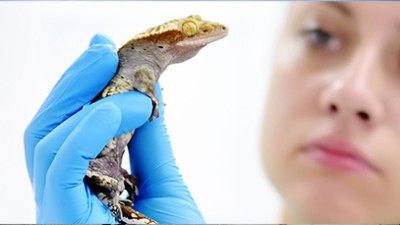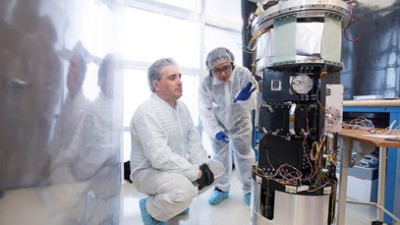News
-
May 1, 2020
![student wearing sunglasses highlights paper under colorful light.]()
First-year students develop imaging system to study historical artifacts
A multidisciplinary team of first-year students has been working to develop an imaging system that can reveal information hidden in historical documents for their Innovative Freshmen Experience project-based course. But with the shift to remote classes, the students left campus with the device nearly complete. Although disappointed, they shifted focus to the opportunities the new situation would create.
-
April 30, 2020
![stars in deep space.]()
How could an explosive Big Bang be the birth of our universe?
Michael Lam, assistant professor of physics and astronomy, explains the Big Bang theory for the "Curious Kids" series published by The Conversation.
-
April 29, 2020
![car plugged into hydrogen fueling station.]()
Program helps high school teachers develop lessons on clean energy and fuel cells
The Clean Energy/Fuel Cells for Electricity Generation program offered by RIT’s School of Chemistry and Materials Science provides high school science teachers with experiments, assignment descriptions, papers and other materials to incorporate into their curriculum.
-
April 28, 2020
![photo of Juliette Daily]()
Student to Student: Microplastic pollution in the Great Lakes
In her research, Juliette Daily uses 3D models to show where microplastic pollution is collecting in the Great Lakes. As a result of her research, she is now the first author of her first published paper.
-
April 26, 2020
![student Morgan Mistysyn.]()
Outstanding Graduate Woman Award recognizes engineering student’s contributions
Morgan Mistysyn, who will graduate this May with a Master of Engineering in engineering management and a bachelor’s in industrial engineering, is the recipient of this year's Outstanding Graduate Woman Award for her leadership role in the RIT chapter of Engineers for a Sustainable World.
-
April 24, 2020
![blast zone with yellow-orange gas in the background.]()
Researchers using drones to detect noxious gas released by explosions
An Ohio-based explosives company called Austin Powder has turned to RIT scientists for a creative approach to quantifying nitrogen oxide gases that on rare occasions are released during mining operations.
-
April 24, 2020
![]()
Student to Student: NUDIX hydrolase enzymes
After transferring to RIT, Kevin DiMagno became a biochemistry major to prepare for medical school after graduation. In this student spotlight, he talks about his interest in characterizing the function of NUDIX hydrolases enzymes and the focus of his research.
-
April 24, 2020
![cattle in pasture]()
Essential pandemic partners
Learn how environmental scientists combine their love of nature with cutting-edge research to help understand the origins of infection.
-
April 23, 2020
![student looking into a microscope]()
Genetic variation for better treatment outcomes
Discover the genetic variation that impacts disease and treatment outcomes as an evolutionary biologist.
-
April 23, 2020
![researcher pointing at equations on dry-erase board.]()
Fixing the forgetting problem in artificial neural networks
An RIT scientist has been tapped by the National Science Foundation to solve a fundamental problem that plagues artificial neural networks. Christopher Kanan, an assistant professor in the Chester F. Carlson Center for Imaging Science, received $500,000 in funding to create multi-modal brain-inspired algorithms capable of learning immediately without excess forgetting.
-
April 22, 2020
![map of Lake Erie with blue dots representing concentrations of plastic pollution.]()
RIT scientists develop first 3D mass estimate of microplastic pollution in Lake Erie
RIT scientists have developed the first three-dimensional mass estimate to show where microplastic pollution is collecting in Lake Erie. The study examines nine different types of polymers that are believed to account for 75 percent of the world’s plastic waste.
-
April 22, 2020
![simulation of the magnetic field lines from a rotating neutron star.]()
NSF funds RIT researchers to develop code for astrophysics and gravitational wave calculations
The National Science Foundation recently awarded researchers at RIT, the University of Illinois at Urbana-Champaign, Louisiana State University, Georgia Tech and West Virginia University grants totaling more than $2.3 million to support further development of the Einstein Toolkit, a community-developed code for simulating the collisions of black holes and neutron stars, as well as supernovas and cosmology.
















